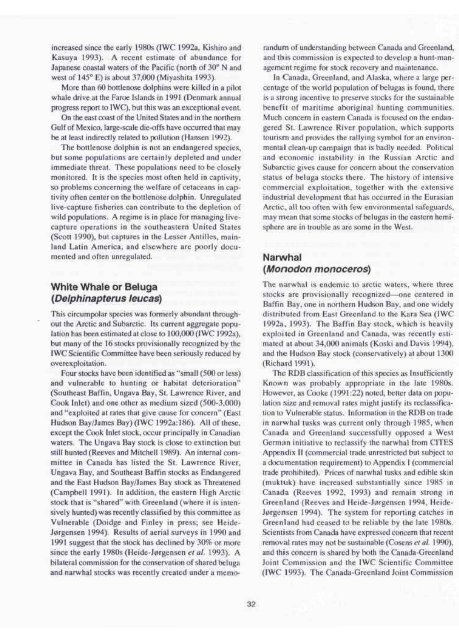Dolphins, Porpoises, and Whales - IUCN
Dolphins, Porpoises, and Whales - IUCN
Dolphins, Porpoises, and Whales - IUCN
Create successful ePaper yourself
Turn your PDF publications into a flip-book with our unique Google optimized e-Paper software.
increased since the early 1980s (IWC 1992a, Kishiro <strong>and</strong><br />
Kasuya 1993). A recent estimate of abundance for<br />
Japanese coastal waters of the Pacific (north of 30° N <strong>and</strong><br />
west of 145° E) is about 37,000 (Miyashita 1993).<br />
More than 60 bottlenose dolphins were killed in a pilot<br />
whale drive at the Faroe Isl<strong>and</strong>s in 1991 (Denmark annual<br />
progress report to IWC), but this was an exceptional event.<br />
On the east coast of the United States <strong>and</strong> in the northern<br />
Gulf of Mexico, large-scale die-offs have occurred that may<br />
be at least indirectly related to pxjllution (Hansen 1992).<br />
The bottlenose dolphin is not an endangered species,<br />
but some populations are certainly depleted <strong>and</strong> under<br />
immediate threat. These populations need to be closely<br />
monitored. It is the species most often held in captivity,<br />
so problems concerning the welfare of cetaceans in captivity<br />
often center on the bottlenose dolphin. Unregulated<br />
live-capture fisheries can contribute to the depletion of<br />
wild populations. A regime is in place for managing livecapture<br />
operations in the southeastern United States<br />
(Scott 1990), but captures in the Lesser Antilles, mainl<strong>and</strong><br />
Latin America, <strong>and</strong> elsewhere are poorly documented<br />
<strong>and</strong> often unregulated.<br />
White Whale or Beluga<br />
{Delphinapterus leucas)<br />
This circumpolar species was formerly abundant throughout<br />
the Arctic <strong>and</strong> Subarctic. Its current aggregate ]3opulation<br />
has been estimated at close to 100,000 (IWC 1992a),<br />
but many of the 16 stocks provisionally recognized by the<br />
IWC Scientific Committee have been seriously reduced by<br />
overexploitation.<br />
Four stocks have been identified as "small (500 or less)<br />
<strong>and</strong> vulnerable to hunting or habitat deterioration"<br />
(Southeast Baffin, Ungava Bay, St. Lawrence River, <strong>and</strong><br />
Cook Inlet) <strong>and</strong> one other as medium sized (500-3,000)<br />
<strong>and</strong> "exploited at rates that give cause for concern" (East<br />
Hudson Bay/James Bay) (IWC 1992a:186). All of these,<br />
except the Cook Inlet stock, occur principally in Canadian<br />
waters. The Ungava Bay stock is close to extinction but<br />
still hunted (Reeves <strong>and</strong> Mitchell 1989). An internal committee<br />
in Canada has listed the St. Lawrence River,<br />
Ungava Bay, <strong>and</strong> Southeast Baffin stocks as Endangered<br />
<strong>and</strong> the East Hudson Bay/James Bay stock as Threatened<br />
(Campbell 1991). In addition, the eastern High Arctic<br />
stock that is "shared" with Greenl<strong>and</strong> (where it is intensively<br />
hunted) was recently classified by this committee as<br />
Vulnerable (Doidge <strong>and</strong> Finley in press; see Heide-<br />
J0rgensen 1994). Results of aerial surveys in 1990 <strong>and</strong><br />
1991 suggest that the stock has declined by 30% or more<br />
since the early 1980s (Heide-J0rgensen et al. 1993). A<br />
bilateral commission for the conservation of shared beluga<br />
<strong>and</strong> narwhal stocks was recently created under a memo<br />
32<br />
r<strong>and</strong>um of underst<strong>and</strong>ing between Canada <strong>and</strong> Greenl<strong>and</strong>,<br />
<strong>and</strong> this commission is expected to develop a hunt-management<br />
regime for stock recovery <strong>and</strong> maintenance.<br />
In Canada, Greenl<strong>and</strong>, <strong>and</strong> Alaska, where a large percentage<br />
of the world population of belugas is found, there<br />
is a strong incentive to preserve stocks for the sustainable<br />
benefit of maritime aboriginal hunting communities.<br />
Much concern in eastern Canada is focused on the endangered<br />
St. Lawrence River population, which supports<br />
tourism <strong>and</strong> provides the rallying symbol for an environmental<br />
clean-up campaign that is badly needed. Political<br />
<strong>and</strong> economic instability in the Russian Arctic <strong>and</strong><br />
Subarctic gives cause for concern about the conservation<br />
status of beluga stocks there. The history of intensive<br />
commercial exploitation, together with the extensive<br />
industrial development that has occurred in the Eurasian<br />
Arctic, all too often with few environmental safeguards,<br />
may mean that some stocks of belugas in the eastern hemisphere<br />
are in trouble as are some in the West.<br />
Narwhal<br />
(Monodon monoceros)<br />
The narwhal is endemic to arctic waters, where three<br />
stocks are provisionally recognized—one centered in<br />
Baffin Bay, one in northern Hudson Bay, <strong>and</strong> one widely<br />
distributed from East Greenl<strong>and</strong> to the Kara Sea (IWC<br />
1992a, 1993). The Baffin Bay stock, which is heavily<br />
exploited in Greenl<strong>and</strong> <strong>and</strong> Canada, was recently estimated<br />
at about 34,000 animals (Koski <strong>and</strong> Davis 1994),<br />
<strong>and</strong> the Hudson Bay stock (conservatively) at about 1300<br />
(Richard 1991).<br />
The RDB classification of this species as Insufficiently<br />
Known was probably appropriate in the late 1980s.<br />
However, as Cooke (1991:22) noted, better data on population<br />
size <strong>and</strong> removal rates might justify its reclassification<br />
to Vulnerable status. Information in the RDB on trade<br />
in narwhal tusks was current only through 1985, when<br />
Canada <strong>and</strong> Greenl<strong>and</strong> successfully opposed a West<br />
German initiative to reclassify the narwhal from CITES<br />
Appendix II (commercial trade unrestricted but subject to<br />
a documentation requirement) to Appendix I (commercial<br />
trade prohibited). Prices of narwhal tusks <strong>and</strong> edible skin<br />
(muktuk) have increased substantially since 1985 in<br />
Canada (Reeves 1992, 1993) <strong>and</strong> remain strong in<br />
Greenl<strong>and</strong> (Reeves <strong>and</strong> Heide-J0rgensen 1994, Heide-<br />
J0rgensen 1994). The system for reporting catches in<br />
Greenl<strong>and</strong> had ceased to be reliable by the late 1980s.<br />
Scientists from Canada have expressed concern that recent<br />
removal rates may not be sustainable (Cosens et al. 1990),<br />
<strong>and</strong> this concern is shared by both the Canada-Greenl<strong>and</strong><br />
Joint Commission <strong>and</strong> the IWC Scientific Committee<br />
(IWC 1993). The Canada-Greenl<strong>and</strong> Joint Commission

















